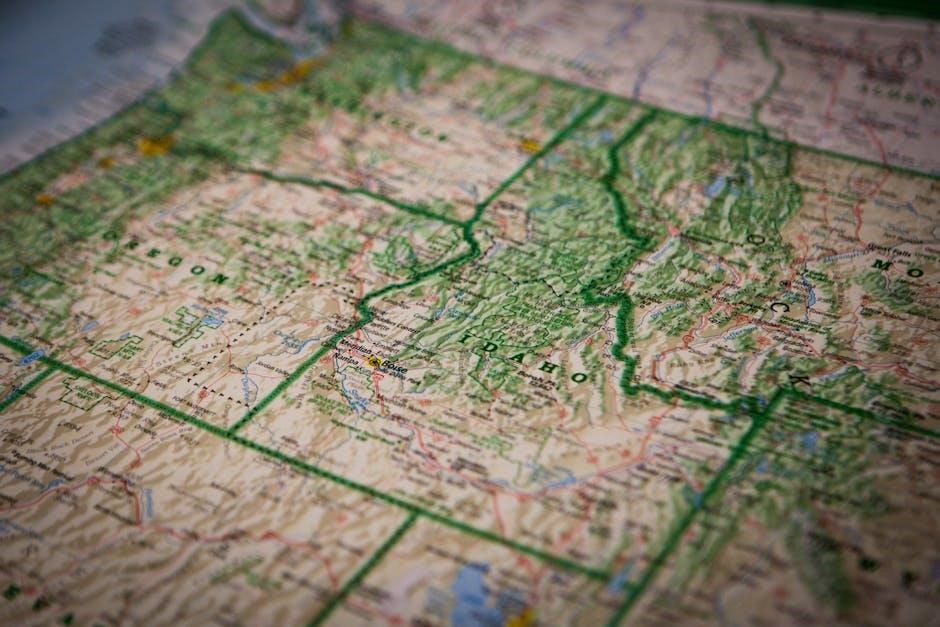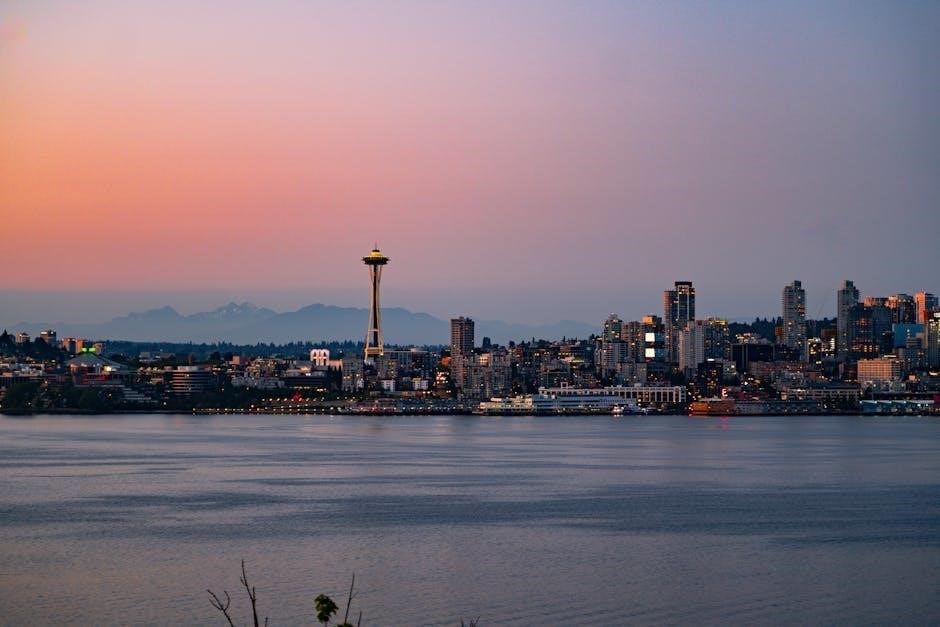
Stormwater management in Western Washington focuses on managing runoff to protect water quality and ecosystems. The Stormwater Manual provides guidelines for effective management practices, ensuring sustainability and compliance.
Overview of Stormwater Challenges in the Pacific Northwest
The Pacific Northwest faces unique stormwater challenges due to heavy rainfall, dense vegetation, and urbanization. Impervious surfaces increase runoff, carrying pollutants like oil, sediment, and nutrients into waterways. Climate change exacerbates these issues, leading to more frequent extreme weather events. Additionally, the region’s sensitive aquatic ecosystems are vulnerable to contamination, threatening biodiversity and water quality. Addressing these challenges requires comprehensive management strategies to mitigate impacts on rivers, streams, and marine life, ensuring sustainable water resources for future generations.
Importance of Stormwater Manuals for Effective Management
Stormwater manuals are critical for effective management in Western Washington, providing standardized guidelines for controlling runoff and protecting water quality. These manuals offer technical specifications, best practices, and regulatory compliance strategies to mitigate pollution and ensure sustainable stormwater systems. By following these guidelines, communities can reduce environmental impacts, enhance public health, and maintain ecological balance, making the manuals indispensable tools for engineers, planners, and policymakers striving to address the region’s unique stormwater challenges effectively.
Regulations and Permits for Stormwater Management
Stormwater management in Western Washington requires adherence to federal, state, and local regulations, including NPDES permits, ensuring compliance and promoting sustainable water quality practices effectively.
Federal, State, and Local Stormwater Regulations in Washington
Stormwater management in Washington is governed by a multi-layered regulatory framework. Federally, the Clean Water Act mandates pollution control, while state regulations are overseen by the Washington State Department of Ecology. Local jurisdictions, such as counties and municipalities, enforce additional stormwater ordinances tailored to regional needs. These regulations aim to protect water quality, prevent pollution, and ensure compliance with environmental standards. Compliance is critical for public health and aquatic ecosystems, with enforcement mechanisms in place to address violations and promote sustainable practices across the state.
NPDES Permits and Their Role in Stormwater Compliance
NPDES (National Pollutant Discharge Elimination System) permits are crucial for ensuring stormwater compliance in Western Washington. These federal permits regulate point-source pollution discharges, including stormwater runoff, into U.S. waters. NPDES permits set specific requirements for stormwater management, ensuring that systems are designed and maintained to minimize pollution. In Western Washington, where heavy rainfall intensifies stormwater challenges, these permits are essential for protecting water quality. They mandate regular inspections, monitoring, and reporting to ensure compliance with environmental standards, safeguarding aquatic ecosystems from harmful pollutants.

Understanding Stormwater Pollutants
Stormwater pollutants include sediment, nutrients, bacteria, and chemicals, often carried by runoff from urban areas, agriculture, and construction. These contaminants degrade water quality and harm aquatic life.
Common Pollutants in Stormwater Runoff
Stormwater runoff often carries pollutants like sediment, nutrients (e.g., nitrogen, phosphorus), bacteria, and chemicals. These contaminants originate from urban areas, construction sites, and agricultural activities. Sediment from soil erosion can cloud waterways, harming aquatic habitats. Nutrients promote excessive algae growth, leading to oxygen depletion. Bacteria from pet waste or sewage pose health risks. Chemicals, including oils and metals, can directly toxify aquatic life. These pollutants degrade water quality and threaten ecosystems, necessitating effective management strategies.

Adverse Impacts of Pollutants on Aquatic Ecosystems
Stormwater pollutants significantly degrade aquatic ecosystems by altering water chemistry and habitats. Excess nutrients like nitrogen and phosphorus can cause algal blooms, deplete oxygen, and harm aquatic life. Sedimentation reduces water clarity, disrupting photosynthesis in plants and threatening species survival. Toxic chemicals and heavy metals accumulate in organisms, leading to biomagnification and long-term ecosystem damage. These pollutants also increase mortality rates in fish and other aquatic organisms, diminish biodiversity, and impair recreational and commercial water uses, highlighting the urgent need for effective stormwater management practices.

Hydrology and Runoff Analysis
Hydrology and runoff analysis are critical for understanding water movement, precipitation, and runoff processes in managing stormwater effectively in Western Washington’s unique climate and geography.
Principles of Hydrology in Stormwater Management
Hydrology in stormwater management focuses on understanding the water cycle, precipitation patterns, and runoff behavior. Key principles include water balance, infiltration, evapotranspiration, and runoff generation. In Western Washington, high rainfall intensity and impervious surfaces amplify runoff. Hydrologic analysis considers factors like soil type, slope, and land use to predict runoff volume and timing. Accurate hydrologic modeling ensures effective design of stormwater systems, mitigating flooding and protecting water quality. These principles guide engineers in creating sustainable solutions tailored to the region’s unique hydrologic conditions.
Methods for Calculating Runoff Rates and Volumes
Calculating runoff rates and volumes involves hydrologic methods like the Rational Method, TR-55, and HEC-1. These techniques use rainfall intensity, drainage area, and runoff coefficients to estimate peak flows and total runoff. In Western Washington, adjustments are made for high rainfall and impervious surfaces. Hydrographs and rainfall-runoff models are also employed to assess stormwater dynamics. Accurate calculations ensure proper sizing of stormwater infrastructure, reducing flooding risks and protecting water quality in urban and rural areas.
Low Impact Development (LID) Practices
LID practices mimic natural hydrology by managing runoff onsite through green infrastructure, reducing impervious surfaces, and filtering pollutants. Techniques include permeable pavements, rain gardens, and bioswales.
Low Impact Development (LID) is a sustainable approach to stormwater management that mimics natural hydrologic processes. By infiltrating, filtering, and storing runoff onsite, LID reduces stormwater volume and improves water quality. Benefits include minimizing urban runoff, reducing pollutant loads, and protecting aquatic habitats. LID also enhances community aesthetics and supports green infrastructure. Its implementation aligns with environmental goals, making it a key strategy for managing stormwater in Western Washington’s sensitive ecosystems while promoting sustainable land use practices.
Case Studies of Successful LID Implementations in Washington
Washington state has demonstrated leadership in LID through innovative projects. In Seattle, the Seattle Public Utilities’ “Roads and Utilities” project integrated LID practices like permeable pavement and rain gardens, reducing stormwater runoff by 50%. Similarly, the 12th Avenue Green Street in Seattle uses green infrastructure to manage runoff effectively. These projects highlight LID’s ability to balance urban development with environmental protection, while also engaging communities in stormwater management. Such successes serve as models for future LID initiatives across the region;
Best Management Practices (BMPs) for Stormwater
Stormwater BMPs are strategies to reduce pollution and manage runoff effectively. They include source controls like permeable pavements and treatment practices such as bioretention systems.
Source Control BMPs for Pollution Prevention
Source control BMPs focus on preventing pollutants from entering stormwater systems. These practices include permeable pavements, spill prevention plans, and regular street sweeping. By reducing pollutant entry at the source, these measures minimize downstream treatment needs. Examples like sediment fences and erosion controls protect water quality. Implementing these BMPs ensures cleaner runoff, reducing risks to aquatic life and decreasing infrastructure maintenance. They are essential for maintaining healthy ecosystems and complying with environmental regulations in Western Washington.
Runoff Treatment BMPs for Water Quality Improvement
Runoff treatment BMPs are designed to remove pollutants from stormwater before discharge. These include bioretention facilities, sand filters, and vegetative swales. Bioretention systems use plants and soil to filter pollutants, while sand filters trap sediments and contaminants. Green infrastructure, like rain gardens, also plays a key role. These practices reduce nutrient and sediment loads, improving water quality. Regular maintenance ensures their effectiveness. By treating runoff, these BMPs protect aquatic habitats and support compliance with water quality standards in Western Washington.

Hydraulic and Hydrologic Design Considerations
Designing stormwater systems requires analyzing precipitation data, peak flows, and drainage areas. Hydrographs and hydraulic calculations ensure efficient runoff management, preventing flooding and erosion in Western Washington.
Designing Stormwater Facilities for Peak Flow Management
Designing stormwater facilities for peak flow management involves analyzing hydrologic and hydraulic conditions to ensure systems can handle extreme rainfall events. In Western Washington, where intense precipitation is common, facilities must be sized to mitigate flooding and erosion. Hydrologic analysis determines runoff rates and volumes, while hydraulic design ensures conveyance and storage capacities meet regulatory standards. Local rainfall patterns, soil types, and drainage areas are critical factors. Proper design minimizes environmental impacts and protects infrastructure, aligning with Washington State’s stormwater management goals and regulations.
Hydraulic Analysis Tools and Techniques
Hydraulic analysis tools and techniques are essential for evaluating stormwater system performance. Software like SWMM and HEC-RAS model water flow dynamics, ensuring systems handle runoff effectively. GIS mapping aids in visualizing drainage patterns and catchment areas. Hydraulic grade line analysis assesses pressure and flow rates in pipes. These tools help design efficient stormwater infrastructure, reducing flooding risks and improving water quality in Western Washington’s wet climate. Regular updates to these tools ensure compliance with evolving stormwater management standards and practices.
Stormwater Management in Specific Land Uses

Stormwater management strategies vary by land use, addressing unique challenges in industrial, commercial, residential, and agricultural areas to mitigate runoff and protect water quality effectively.
Industrial and Commercial Stormwater Management
Industrial and commercial areas face unique stormwater challenges due to impervious surfaces and potential pollutant sources like chemicals, oils, and sediments. Effective management requires implementing BMPs such as spill prevention plans, regular site inspections, and treatment systems to reduce contaminant discharge. Parking lots, rooftops, and loading areas must be designed with runoff controls, while industrial facilities should prioritize waste management and employee training to minimize environmental impact. Compliance with local regulations ensures water quality protection and aligns with Western Washington’s stormwater goals.
Residential and Agricultural Stormwater Best Practices
Residential and agricultural areas require tailored stormwater strategies to mitigate runoff impacts. For homes, installing rain barrels, permeable pavements, and rain gardens can reduce stormwater volume and improve water quality. In agricultural settings, practices like conservation tillage, cover crops, and buffer strips help control runoff and prevent nutrient and sediment loss. Regular maintenance of drainage systems and education on pollution prevention are essential for long-term effectiveness. These practices protect waterways and support sustainable land use in Western Washington.

Public Education and Outreach
Public education and outreach are crucial for raising awareness about stormwater management. Engaging the community through workshops, brochures, and digital platforms fosters participation and responsibility.
Importance of Community Involvement in Stormwater Management
Community involvement is vital for effective stormwater management, as it fosters awareness and responsibility among residents. Engaging locals ensures that stormwater practices align with community needs and priorities. Public participation in initiatives like clean-up events or reporting illicit discharges enhances compliance with regulations. Educational programs and outreach materials empower individuals to make informed decisions, reducing pollution and protecting water quality. Strong community involvement leads to more sustainable and supported stormwater management solutions, benefiting both urban and natural environments in Western Washington.
Effective Strategies for Public Education Campaigns
Successful public education campaigns for stormwater management rely on clear, engaging messaging and accessible delivery methods. Visual aids like infographics and videos simplify complex concepts, while community events and workshops foster direct interaction. Leveraging social media and partnerships with schools enhances reach. Tailoring messages to specific audiences, such as homeowners or businesses, ensures relevance. Regular feedback loops allow campaigns to adapt and improve, fostering long-term engagement and behavior change that protects water quality in Western Washington.
Maintenance and Inspection of Stormwater Systems
Regular maintenance and inspections are crucial for ensuring stormwater systems function effectively, preventing clogs and environmental harm by removing debris and addressing damage promptly.
Regular Maintenance Requirements for Stormwater Infrastructure
Stormwater infrastructure requires routine maintenance to ensure optimal performance. This includes clearing debris from catch basins, inspecting pipes for damage, and managing vegetation growth. Regular sediment removal from ponds and swales prevents clogging and maintains water flow. Seasonal inspections, especially before heavy rainfall, are critical to identify and address potential issues early. Maintenance schedules should be tailored to the specific design and location of stormwater systems, ensuring compliance with local regulations and protecting water quality. Proper upkeep extends system lifespan and prevents costly repairs.
Inspection Checklists and Reporting Guidelines
Stormwater infrastructure inspections require detailed checklists to ensure thorough evaluations. Visual assessments of structural integrity, erosion, and debris accumulation are essential. Checklists should include items like inlet and outlet conditions, vegetative health, and signs of pollution. Reporting guidelines mandate documenting findings, including photos and repair recommendations. Inspections must occur at specified intervals, with results submitted to regulatory agencies. Standardized reporting formats ensure clarity and compliance, aiding in proactive maintenance and enhancing overall stormwater management effectiveness in Western Washington.

Integration with Other Urban Planning Initiatives
Stormwater management integrates with urban planning by aligning with transportation, parks, and green infrastructure goals, promoting holistic approaches to land use and community livability.
Stormwater Management and Green Infrastructure
Green infrastructure, such as rain gardens, permeable pavements, and green roofs, enhances stormwater management by mimicking natural hydrologic processes. These practices reduce runoff, improve water quality, and provide ecosystem benefits. Integrating green infrastructure into urban planning supports biodiversity, mitigates urban heat islands, and enhances community aesthetics. In Western Washington, where rainfall is abundant, green infrastructure aligns with regional environmental goals, offering sustainable solutions for managing stormwater while promoting ecological balance and community well-being.
Coordinating Stormwater Plans with Urban Development Goals

Integrating stormwater management with urban development ensures sustainable growth while protecting water quality. By aligning stormwater plans with land-use goals, communities can reduce runoff, prevent pollution, and enhance green spaces. Low Impact Development (LID) practices, such as rain gardens and bioswales, support both stormwater control and urban aesthetics. Collaboration between planners, engineers, and stakeholders is key to balancing development needs with environmental objectives. This coordinated approach fosters resilient, eco-friendly cities that thrive economically and environmentally.
Case Studies and Success Stories
Western Washington’s stormwater successes include Puget Sound restoration projects and Seattle’s Green Stormwater Infrastructure. These initiatives highlight effective runoff management and community engagement, improving water quality.
Successful Stormwater Management Projects in Western Washington
Several stormwater management projects in Western Washington have demonstrated exceptional results. The Puget Sound region has implemented innovative green infrastructure, such as rain gardens and permeable pavements, to reduce runoff. Seattle’s “Green Stormwater Infrastructure Program” has successfully decreased stormwater pollutants by 50% in targeted areas. Tacoma’s “Stormwater Park” uses natural systems to filter runoff, improving water quality; These projects highlight the effectiveness of integrated stormwater management strategies and community engagement in achieving environmental goals and improving local ecosystems.
Lessons Learned from Challenging Stormwater Scenarios
Western Washington has faced complex stormwater challenges, including intense rainfall and urbanization. Key lessons include the importance of adaptive management and integrating green infrastructure. Projects like Seattle’s “RainWise” program demonstrated that community engagement and incentives can significantly reduce stormwater runoff. However, challenges like aging infrastructure and funding constraints highlight the need for long-term investment and interagency collaboration. These experiences underscore the importance of resilience, innovation, and proactive planning to address stormwater management effectively in the region.

Emerging Trends and Technologies
Green infrastructure, smart sensors, and data analytics are transforming stormwater management. These innovations enhance efficiency, reduce pollution, and improve climate resilience in Western Washington.
Innovative Stormwater Management Technologies
Emerging technologies like permeable pavements, green roofs, and biofiltration systems are enhancing stormwater management in Western Washington. Smart sensors and IoT devices enable real-time monitoring of water quality and flow. Advanced filtration systems, such as biochar and membrane technologies, improve pollutant removal. Modular stormwater systems and climate-resilient designs are gaining traction, offering scalable solutions for urban and rural areas. These innovations integrate with green infrastructure, promoting sustainable water cycles and reducing environmental impacts, while supporting compliance with evolving regulations and community resilience goals.
 gray’s manual of botany
gray’s manual of botany  waterdrop x series undersink reverse osmosis system x16 manual
waterdrop x series undersink reverse osmosis system x16 manual  kia service manual pdf free download
kia service manual pdf free download  2014 chevy cruze manual transmission
2014 chevy cruze manual transmission  manual de manejo de carolina del norte en espanol
manual de manejo de carolina del norte en espanol  delta pro 3 user manual
delta pro 3 user manual